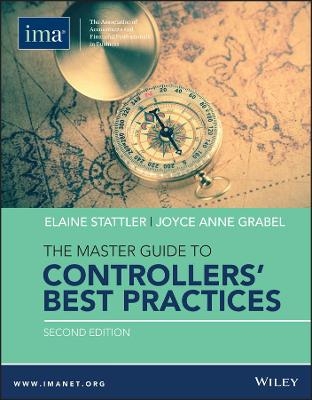
The Master Guide to Controllers' Best Practices
John Wiley & Sons Inc (Verlag)
978-0-9967293-2-1 (ISBN)
Today’s controllers are in leadership roles that put them in the unique position to see across all aspects of the operations they support. The Master Guide to Controllers’ Best Practices, Second Edition has been revised and updated to provide controllers with the information they need to successfully monitor their organizations’ internal control environments and offer direction and consultation on internal control issues. In addition, the authors include guidance to help controllers carryout their responsibilities to ensure that all financial accounts are reviewed for reasonableness and are reconciled to supporting transactions, as well as performing asset verification.
Comprehensive in scope the book contains the best practices for controllers and:
Reveals how to set the right tone within an organization and foster an ethical climate
Includes information on risk management, internal controls, and fraud prevention
Highlights the IT security controls with the key components of successful governance
Examines the crucial role of the controller in corporate compliance and much more
The Master Guide to Controllers’ Best Practices should be on the bookshelf of every controller who wants to ensure the well-being of their organization.
In addition to their traditional financial role, today’s controllers (no matter how large or small their organization) are increasingly occupying top leadership positions. The revised and updated Second Edition of The Master Guide to Controllers’ Best Practices provides an essential resource for becoming better skilled in such areas as strategic planning, budgeting, risk management, and business intelligence. Drawing on the most recent research on the topic, informative case studies, and tips from finance professionals, the book highlights the most important challenges controllers will face.
Written for both new and seasoned controllers, the Guide offers a wide range of effective tools that can be used to improve the skills of strategic planning, budgeting, forecasting, and risk management. The book also contains a resource for selecting the right employees who have the technical knowledge, analytical expertise, and strong people skills that will support the controller’s role within an organization. To advance overall corporate performance, the authors reveal how to successfully align strategy, risk management, and performance management. In addition, the Guide explains what it takes to stay ahead of emerging issues such as healthcare regulations, revenue recognition, globalization, and workforce mobility.
As controllers adapt to their new leadership roles and assume more complex responsibilities, The Master Guide to Controllers’ Best Practices offers an authoritative guide to the tools, practices, and ideas controllers need to excel in their profession.
ELAINE STATTLER, APM, CPC, is a principal of Editorial Direction LLC in New London, Connecticut. She specializes in professional and business publishing and is Editor-in-Chief of IOFM’s Controller’s Report. JOYCE ANNE GRABEL is a principal of Editorial Direction LLC, and the author and editor of numerous articles, newsletters, manuals, videos, and employee training materials.
About IMA (Institute of Management Accountants) 3
About the Authors 3
Controller Advisors 4
Other Acknowledgments 4
What This Guide Will Do For You 15
Section 1. Overseeing Governance, Compliance, Risk Management, and Internal Controls 17
Introduction 19
Chapter 1. Tone at the Top and Corporate Governance 21
Chapter 2. Risk Management, Internal Controls, and Fraud Prevention 45
Chapter 3. It Security Controls 87
Chapter 4. The Crucial Role of the Controller in Corporate Compliance 109
Section 2. Business Process Best Practices 183
Introduction 185
Chapter 5. Procurement and the Move to P2p 187
Chapter 6: Accounts Payable 197
Chapter 7. Payroll 243
Payroll Withholdings: Paid By Employees 245
Payroll Taxes, Costs, and Benefits Paid By Employers 248
Employer Contributions to Defined Contribution Plans 250
The Fair Labor Standards Act (Flsa) 251
Salaries, Wages, and Overtime Pay 256
Best Practices and Process Improvement 259
Tax and Compliance Issues 263
Special Considerations When Paying Employees 266
Benefits 278
Unemployment Claims 285
Withholding 286
Internal Controls 291
Record Retention 292
Chapter 8. Accounts Receivable 297
Chapter 9. The Supply Chain 337
Chapter 10. Inventory Control 347
Chapter 11. Treasury’s Role In Cash Management and Working Capital 361
Chapter 12. Shared Services and Outsourcing 391
Section 3. /Planning, Budgeting, Forecasting, and Financial Close Best Practices 401
Introduction 403
Chapter 13. Budgeting Best Practices 405
Chapter 14. Financial Close Processes and Procedures 429
Chapter 15. Financial Statement Fraud 445
Section 4. Measuring Performance 449
Introduction 451
Chapter 16. Benchmarking and Metrics 453
Chapter 17. Developing a Metrics Roadmap 463
Section 5. Process Improvement Through Automation & Technology 485
Introduction 487
Chapter 18. Going Paperless 489
Chapter 19. Making Your Case for Automation 509
Chapter 20. Project Management and Implementation 521
Section 6. Leadership and The Evolving Role of the Controller 531
Introduction 533
Chapter 21. Financial Leadership 535
| Erscheinungsdatum | 07.08.2020 |
|---|---|
| Verlagsort | New York |
| Sprache | englisch |
| Maße | 218 x 274 mm |
| Gewicht | 1565 g |
| Themenwelt | Wirtschaft ► Betriebswirtschaft / Management ► Rechnungswesen / Bilanzen |
| ISBN-10 | 0-9967293-2-1 / 0996729321 |
| ISBN-13 | 978-0-9967293-2-1 / 9780996729321 |
| Zustand | Neuware |
| Haben Sie eine Frage zum Produkt? |
aus dem Bereich


